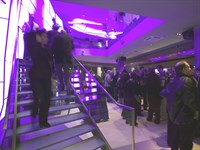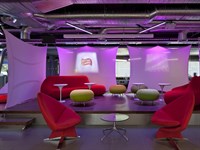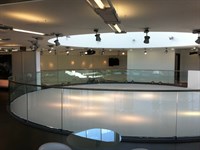As part of the overall design of your tensile fabric structure, lighting should be considered as an option to really help enhance its form. Lighting can be incorporated into any structure, whether it be in an interior, exterior or exhibition setting.
 LED lighting example – Cargo RestaurantWe work with a number of specialised lighting companies and with our wealth of experience, we can help advise you on what would work best with your particular structure. For interior structures, for example, front light may be used to give a soft reflected light for ceilings or screens. For exterior canopies, upward lighting can bounce light back onto surfaces. And for exhibition structures, the list is endless! There are numerous ways to draw attention to an exhibition display using lighting. Some of the options available are as follows:
LED lighting example – Cargo RestaurantWe work with a number of specialised lighting companies and with our wealth of experience, we can help advise you on what would work best with your particular structure. For interior structures, for example, front light may be used to give a soft reflected light for ceilings or screens. For exterior canopies, upward lighting can bounce light back onto surfaces. And for exhibition structures, the list is endless! There are numerous ways to draw attention to an exhibition display using lighting. Some of the options available are as follows:
 Lighting colour changes on office screens – Cussons, ManchesterLED is a modern popular source for lighting. It offers colour change options, high lux levels, low heat generation and often vary small light fittings. Add this to a fabric structure – typically for interior or exhibition use - and you have a light source that you can easily hide on your canopy and that won't interfere with the aesthetics of the form.
Lighting colour changes on office screens – Cussons, ManchesterLED is a modern popular source for lighting. It offers colour change options, high lux levels, low heat generation and often vary small light fittings. Add this to a fabric structure – typically for interior or exhibition use - and you have a light source that you can easily hide on your canopy and that won't interfere with the aesthetics of the form.
Colour change is a great feature of modern LED, allowing you to choose a white fabric, that is very often less expensive than coloured ones  Backlighting example – Wem Town Hall(and of course never goes out of fashion) and then light it with any colour under the sun! Colour washes can be seen here at Cussons – changing through many colours of the spectrum.
Backlighting example – Wem Town Hall(and of course never goes out of fashion) and then light it with any colour under the sun! Colour washes can be seen here at Cussons – changing through many colours of the spectrum.
Backlighting is a simple way of making your structure stand out without being visually interrupted by having to see your light source.  Front lighting example – Pharmaceutical Exhibition Stand, CopenhagenTypically used in exhibition environments, fabric forms lend themselves to this technique beautifully – care just needs to be taken when selecting your fabric and light source, to make sure that no 'spotting' occurs (when you can see your light source through the fabric). This is avoided with very close weave fabrics that are heat treated after weaving or by diffusing you light source locally before the resultant light hits the back of the fabric.
Front lighting example – Pharmaceutical Exhibition Stand, CopenhagenTypically used in exhibition environments, fabric forms lend themselves to this technique beautifully – care just needs to be taken when selecting your fabric and light source, to make sure that no 'spotting' occurs (when you can see your light source through the fabric). This is avoided with very close weave fabrics that are heat treated after weaving or by diffusing you light source locally before the resultant light hits the back of the fabric.
Front lighting or washing with colour is again an ideal lighting technique for fabric canopies, as double curved fabric is beautifully emphasised,  Stage cloth effect – Porsche 918 Revealadding depth and increasing the contract of the shape. The scheme here in Copenhagen shows this.
Stage cloth effect – Porsche 918 Revealadding depth and increasing the contract of the shape. The scheme here in Copenhagen shows this.
Of course when the two effects of front and back lighting are combined with a mesh fabric, you can introduce the 'stage cloth effect' where the fabric can appear solid (when front lit) but transparent when back lit. This is a great effect when you want to move the emphasis from one space to another, for example if your exhibition client wishes the stand to convey more than one message.

 Seen our NEW range of exhibition products? Easy to specify, use and reuse…
Seen our NEW range of exhibition products? Easy to specify, use and reuse… Having problems with bad interior acoustics? Solve this with custom made fabric screens and ceilings…
Having problems with bad interior acoustics? Solve this with custom made fabric screens and ceilings… Reduce interior sound reverberation with our tensile fabric acoustic products…
Reduce interior sound reverberation with our tensile fabric acoustic products… Looking for unique event signage structures? See our bespoke exhibition portfolio…
Looking for unique event signage structures? See our bespoke exhibition portfolio… External canopies made to measure… …and built to last. See our bespoke exteriors portfolio…
External canopies made to measure… …and built to last. See our bespoke exteriors portfolio… Need permanent interior fabric sails or sunshades? See our bespoke interior portfolio…
Need permanent interior fabric sails or sunshades? See our bespoke interior portfolio…


